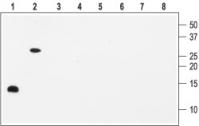BDNF Rabbit Polyclonal Antibody
CNY 11,000.00
| Cited in 6 publications. |
CNY 3,080.00
CNY 300.00
CNY 1,430.00
CNY 2,900.00
CNY 6,650.00
Specifications
| Product Data | |
| Applications | IHC, WB |
| Recommend Dilution | WB: 1:200-1:2000; IHC: 1:100-1:3000 |
| Reactivity | Human, Mouse, Rat |
| Host | Rabbit |
| Clonality | Polyclonal |
| Immunogen | Peptide (C)VLEKVPVSKQLK, corresponding to amino acid residues 166-178 of human BDNF (precursor). |
| Formulation | Lyophilized. Concentration before lyophilization ~0.8mg/ml (lot dependent, please refer to CoA along with shipment for actual concentration). Buffer before lyophilization: Phosphate buffered saline (PBS) pH 7.4, 1% BSA, 0.025% NaN3. |
| Reconstitution Method | Add 50 ul double distilled water (DDW) to the lyophilized powder. |
| Purification | Affinity purified on immobilized antigen. |
| Conjugation | Unconjugated |
| Storage Condition | Store at -20°C as received. |
| Gene Name | brain-derived neurotrophic factor |
| Database Link | |
| Background | Brain derived neurotrophic factor (BDNF) is a member of the neurotrophin family of growth factors which includes nerve growth factor (NGF), neurotrophin-3 (NT-3) and neurotrophin-4/5 (NT-4/5). All neurotrophins are synthesized as preproneurotrophin precursors that are subsequently processed within the intracellular transport pathway to yield proneurotrophins that are further processed to generate the mature form. The mature form of BDNF is a non-covalent stable homodimer that can be secreted in both constitutive and regulated pathways. BDNF conveys its activity by binding to two classes of receptors, a member of the Trk receptor tyrosine kinase family (TrkB) and the pan-neurotrophin receptor p75NTR. Binding of BDNF to the TrkB receptor triggers ligand-induced dimerization and autophosphorylation of tyrosine residues. This activates various signaling cascades such the MAPK, PI3K and PLC? pathways that are involved in cell growth, survival and differentiation of neurons in the central and peripheral nervous system. Interestingly, recent evidence suggests that BDNF may influence target cell function via ion channel modulation. Ion channel activity in the target cells can be modulated by a TrkB-mediated mechanism that has not yet been determined. BDNF is able to block both Kv1.3 and AMPA-subtype glutamate ion channel currents in sensory neurons, while it can induce activation of the TRPC3 cation channel in neurons and of the Nav1.9 Na+ channel in hippocampal neurons. These newly recognized BDNF actions underlie its â??rapidâ? neuronal functions that include changes in neuronal excitability, plasticity and synaptic transmission. Due to the high degree of homology between the different neurotrophins it has been difficult to produce truly specific antibodies against any of them. We have now produced a highly specific antibody against BDNF which recognizes exclusively BDNF. |
| Synonyms | ANON2; BULN2 |
| Reference Data | |
| Protein Families | Adult stem cells, Druggable Genome, Embryonic stem cells, ES Cell Differentiation/IPS, Induced pluripotent stem cells, Secreted Protein, Transmembrane |
| Protein Pathways | Huntington's disease, MAPK signaling pathway, Neurotrophin signaling pathway |
Citations (6)
| The use of this Antibodies has been cited in the following citations: |
|---|
|
The Polyunsaturated Fatty Acid EPA, but Not DHA, Enhances Neurotrophic Factor Expression through Epigenetic Mechanisms and Protects against Parkinsonian Neuronal Cell Death
,null,
International Journal of Molecular Sciences
,PubMed ID 36555817
[BDNF]
|
|
Effect of amniotic fluid stem cell transplantation on the recovery of bladder dysfunction in spinal cord-injured rats
,Liang, CC;Shaw, SS;Ko, YS;Huang, YH;Lee, TH;,
Sci Rep
,PubMed ID 32572272
[BDNF]
|
|
PGC-1α-FNDC5-BDNF signaling pathway in skeletal muscle confers resilience to stress in mice subjected to chronic social defeat
,Zhan, G;Huang, N;Li, S;Hua, D;Zhang, J;Fang, X;Yang, N;Luo, A;Yang, C;,
Psychopharmacology (Berl.) 2018
,PubMed ID 30259075
[BDNF]
|
|
Cocaine-mediated activation of microglia and microglial MeCP2 and BDNF production
,Cotto, B;Li, H;Tuma, RF;Ward, SJ;Langford, D;,
Neurobiol. Dis.
,PubMed ID 29859319
[BDNF]
|
|
Blockade of soluble epoxide hydrolase attenuates post-ischemic neuronal hyperexcitation and confers resilience against stroke with TrkB activation
,Chang, LH;Lin, HC;Huang, SS;Chen, IC;Chu, KW;Chih, CL;Liang, YW;Lee, YC;Chen, YY;Lee, YH;Lee, IH;,
Sci Rep
,PubMed ID 29311641
[BDNF]
|
|
Protective Effect of Hyperbaric Oxygen on Cognitive Impairment Induced by D-Galactose in Mice
,Chen, X;Li, Y;Chen, W;Nong, Z;Huang, J;Chen, C;,
Neurochem. Res.
,PubMed ID 27485714
[BDNF]
|
Documents
| Product Manuals |
| FAQs |
| SDS |
Resources
| 抗体相关资料 |


 United States
United States
 Germany
Germany
 Japan
Japan
 United Kingdom
United Kingdom
 China
China


